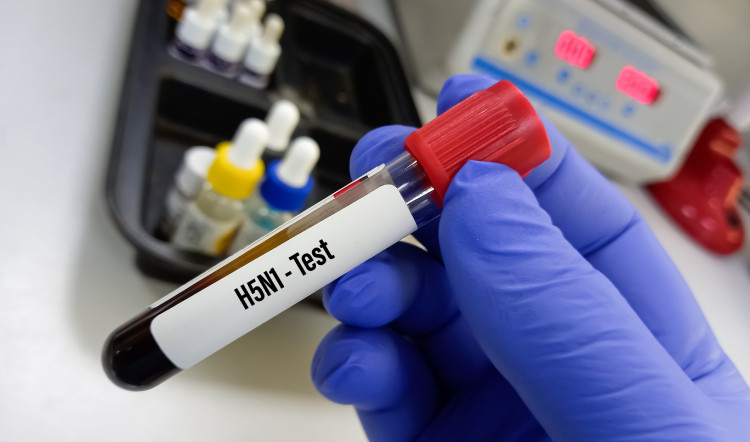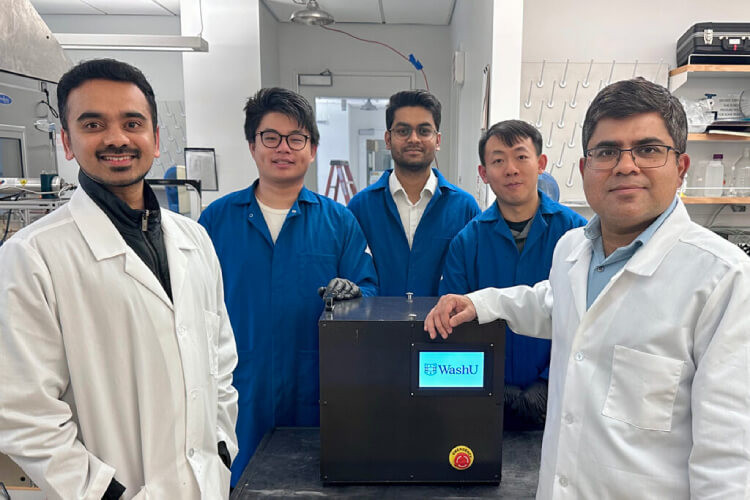Airborne Bird Flu Detection in Under 5 Minutes with Sensor
11-04-2025 | By Robin Mitchell

While traditional methods of monitoring bird flu have made significant strides in recent decades, the urgent need for rapid, accurate, and scalable detection solutions has spurred the exploration of innovative technologies. Recently, researchers at Washington University in Saint Louis unveiled a breakthrough biosensor that can identify the highly pathogenic H5N1 avian influenza virus in under five minutes—far faster than conventional tests.
Key Thing to Know:
- Breakthrough detection speed: A new biosensor developed by Washington University can detect airborne H5N1 avian influenza in under five minutes—far faster than conventional methods.
- Real-time, on-site monitoring: Designed for autonomous deployment in livestock ventilation systems, the sensor provides continuous surveillance without the need for specialist training.
- Scientific innovation at its core: The sensor uses aptamer-based electrochemical detection to accurately identify low concentrations of airborne virus particles, even in complex farm environments.
- Supports wider biosecurity strategies: While rapid detection is vital, researchers emphasise the need to integrate it with disinfection protocols, access control, and targeted vaccination.
What challenges does bird flu detection currently face, what exactly did the Washington University team develop, and what are the broader implications of this rapid detection sensor for controlling future outbreaks?
Understanding the Challenges of Bird Flu Detection and Control
Bird flu, a disease that affects animals in the avian family, is something that we often hear about as beings severe. Despite this disease not affecting human health, it has numerous serious consequences that make it something not to be trifled with.
The first recorded outbreak of bird flu occurred in 1959, with subsequent outbreaks in 1963, 1979, and 1997. Each of these outbreaks had significant economic and human health impacts, with one example being the rapid spread of the virus in 2003, which led to over 250 million birds being culled in the UK alone.
Technological Limitations in Real-Time Detection
The evolution of biosensors has significantly improved disease detection, with rapid diagnostic tests now available for various diseases. However, these tests are not without their limitations, and there is still a long way to go in terms of developing technology that can provide immediate results.
The challenge of real-time detection lies in the need for rapid, accurate, and reliable results. Current technology is not capable of providing immediate results, leading to a gap between detection speed and response time. This gap can be critical in preventing outbreaks, as the speed at which a disease is detected directly affects the success of containment efforts. The limitations of current technology also lead to issues with accuracy and reliability in high-pressure, real-time settings.
The detection of bird flu also relies heavily on laboratory testing, which is a time-consuming and labour-intensive process. The need for specialised equipment and trained professionals to operate it means that testing is often limited to large laboratories equipped with the necessary resources. The logistical challenges involved in transporting samples to these labs can further delay the diagnosis process. As a result, there is often a significant delay between the initial detection of a suspected outbreak and the confirmation of a positive result.
Impact on Agriculture and Global Biosecurity Efforts
Considering that the poultry industry is a vital part of the global food supply chain, the loss of even a small percentage of birds can have a significant impact on food prices and availability. The challenges faced by the poultry industry are not limited to the economic impact of bird flu; maintaining biosecurity measures to minimise the risk of outbreaks is a major challenge for farmers and the poultry industry as a whole.
The control and containment of bird flu is also a complex issue that is often plagued by inadequate infrastructure and resources. The enforcement of quarantine and movement restrictions is a critical step in preventing the spread of the virus, but this can be difficult to achieve in regions with limited resources and infrastructure. The variability in response strategies across different countries and regions also presents a significant challenge in controlling and containing outbreaks.
The human health risks associated with bird flu are also major concerns for public health officials around the world. The potential for the virus to mutate and become transmissible to humans is a serious threat, and the risks posed by past zoonotic disease pandemics, such as SARS and Ebola, should not be underestimated. The spread of bird flu to humans could have catastrophic consequences, and the need for effective monitoring and prevention strategies is essential in protecting public health.
Washington University Researchers Develop Biosensor to Detect Bird Flu in Under Five Minutes
Researchers at Washington University in Saint Louis have developed a biosensor that can detect airborne H5N1 avian influenza in under five minutes. Designed for use in high-density agricultural operations, this innovative system significantly reduces the lag time between infection and response, a crucial factor in controlling fast-moving outbreaks.
The biosensor addresses a persistent limitation in current pathogen detection infrastructure: diagnostic delays. Traditional testing methods often require specialised labs and can take over ten hours to deliver results, delaying containment efforts. By offering a five-minute detection window, the biosensor provides a real-time response capability that can inform immediate isolation, cleaning, or culling procedures before a pathogen spreads further.
Measuring about the size of a desktop printer, the device can be installed within a farm’s ventilation system, where it samples ambient air from poultry or cattle housing. Airborne particles enter a “wet cyclone” sampling unit, where they are trapped in a fluid medium and automatically transferred to the biosensor for rapid analysis. The system operates autonomously and does not require users to have biochemical expertise, making it accessible for widespread adoption across various types of livestock environments.

Joseph Puthuserry (left), Yuezhi August Li, Joshin Kumar, Shu-Wen You, and Professor Rajan Chakrabarty pictured with the integrated H5N1 sampling-sensing unit developed by the research team. (Image courtesy of the AIR Lab)
Scientific Basis for Rapid Virus Detection
A key advantage of the biosensor is its nondestructive testing approach. Even after detecting viral particles, the captured samples remain intact for further laboratory analysis using PCR or other gold-standard diagnostic techniques. This feature not only enhances data integrity but also supports traceability and epidemiological tracking, particularly valuable in coordinated regional or national responses.
The device was developed by Professor Rajan Chakraborty and his team, who specialise in energy, environmental, and chemical engineering. At its core, the sensor utilises electrochemical capacitive biosensing, a technology that enables ultra-sensitive detection of virus and bacterial loads by measuring subtle changes in electrical capacitance.
The detection mechanism is centred on aptamers—synthetic DNA strands engineered to bind selectively to specific viral proteins. These aptamers are chemically bonded to a modified carbon electrode via a glutaraldehyde crosslinker. The result is a highly responsive surface capable of identifying H5N1 even at concentrations as low as 100 viral RNA copies per cubic metre of air. This precision makes the biosensor a reliable early-warning system in even low-exposure environments.
Broader Implications for Public Health and Biosecurity
Its development comes at a critical time. H5N1 has shown increasing virulence and cross-species transmission potential, with recent USDA data reporting 35 new infections in dairy cattle within a single month. The virus has also caused fatalities in other mammals, including cats, and poses an emerging zoonotic threat to humans. The USDA has responded by conditionally approving an avian flu vaccine to support prevention efforts, yet detection remains the first line of defence.
According to the research team, detection alone is not enough. The biosensor is most effective when used in conjunction with a broader biosecurity framework. This includes restricted facility access, automated disinfection procedures, and targeted vaccination campaigns. Real-time environmental data enhances these systems by enabling faster, evidence-led responses with less reliance on manual testing and human intervention.
By combining scalability, affordability, and speed, the biosensor presents a promising step forward in the fight against airborne viral pathogens. It also serves as a model for future diagnostic tools aimed at other viruses, including SARS-CoV-2 and influenza A variants, with potential for deployment in healthcare, transportation hubs, and livestock production networks.
Shaping Tomorrow's Bird Flu Prevention and Control
As the world continues to grapple with the challenges posed by bird flu, researchers and engineers continue racing to develop new technologies that can help prevent and control the spread of the virus, with the new sensor being developed by researchers at Washington University in Saint Lois a prime example.
However, the development of rapid sensor technologies is just one example of the many innovations being made in the field of bird flu prevention and control. Other technologies being explored include advanced data analytics and artificial intelligence, which can be used to analyse large amounts of data and identify potential outbreaks before they happen. Additionally, researchers are also exploring the use of drones and other remote sensing technologies to monitor large areas of land and detect potential outbreaks early.
While these technologies hold great promise, they are not without their challenges. One of the biggest challenges facing the development of rapid sensor technology is the need for accurate and reliable results. The sensors need to be able to detect the virus in a timely manner, but they also need to be able to distinguish between false positives and false negatives. This can be a challenging task, especially when dealing with airborne particles that can be easily contaminated. Furthermore, the sensors need to be able to operate in a wide range of environments, including farms and poultry operations, which can be challenging due to the presence of dust, moisture, and other environmental factors.
Another challenge facing the development of rapid sensors is the need for cost-effective solutions. While the sensors developed by researchers are able to detect the virus quickly and accurately, they are often expensive and difficult to deploy. As such, they are often limited to use in large-scale poultry operations and other high-risk areas.
However, if the sensors can be made more cost-effective, they could be deployed in smaller operations and even in individual farms, which would help to prevent the spread of the virus in the early stages.

